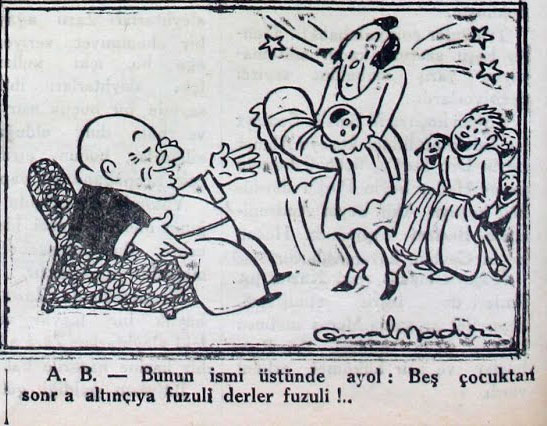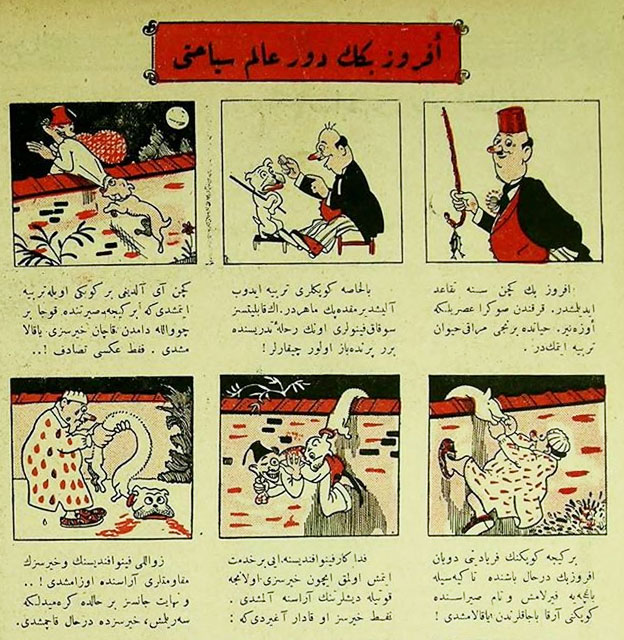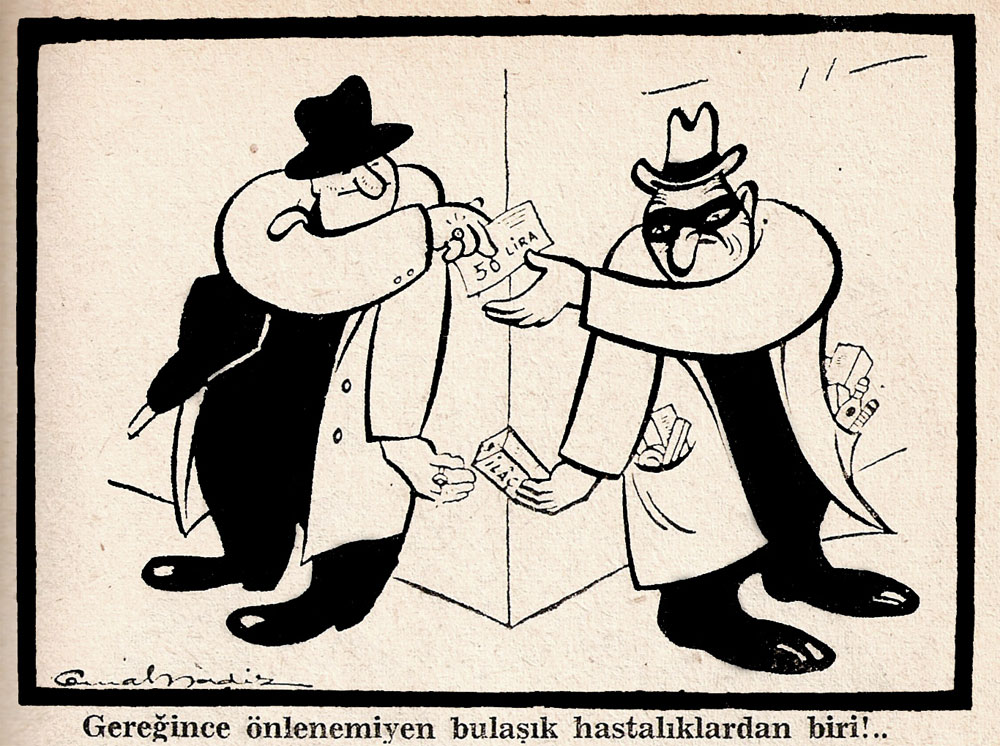'Amcabey'.
Cemal Nadir Güler was a pioneer in Turkish cartoon art, and is often referred to as the "Father of Turkish Comics" or the "Turkish Walt Disney". While the art form originally appealed more to the elite and well educated people, it was Cemal Nadir's understandable drawing style that made cartoons gain popularity among common people. This was largely due to his creation 'Amcabey' (1929-1947), one of Turkey's first recurring comic characters. Among his other creations are 'Efruz Bey' (1924), 'Ak'la Kara' (1938)', 'Dalkavuk' (1938), 'Yeni Zengin' (1941) and 'Dede ile Torun' (1941).
In this early cartoon (1928), Cemal Nadir shows his talent for calligraphy.
Early life and work
Cemal Nadir was born on 13 July 1902 into a family of Bulgarian immigrants in Bursa. Güler is the surname he assumed after the Surname Law of 1934. He shared his artistic talents with his father, Şevket Güler, who was a calligrapher for the law courts. After secondary school, the family finances didn't allow further studies. By entering the state exam, he gained the right to study engineering in Germany, much to the pleasure of his parents. Nadir desired to become a painter instead, and applied for the Sanâyi-i Nefîse Mektebi School of Fine Arts in Istanbul. He passed his entrance exam, for which he intensely studied human anatomy, but the examination committee did not accept him at the Faculty. Instead he had to start his working life as a mechanic's apprentice. In 1920 the city of Bursa was overtaken by the Greek army during the Turkish War of Independence (1919-1922). As his father lost his job, Nadir opened a small calligraphy workshop in Bursa's secondhand booksellers district, where he painted signs for local shops and cinemas. The job was however not enough to earn a living so he additionally had to work as a drawing teacher in primary schools from several districts of Bursa. When Turkey switched from Arabic script to the Latin alphabet in 1928, his luck changed. All panels and signs had to be replaced, and painters were in high demand. In the meantime, Nadir had not neglected his artistic ambitions and made his first steps as a caricaturist.
'Efruz Bey, the globetrotter'.
Cartoon history in Turkey
In Turkey, comics and cartoon art was introduced during the last years of the Ottoman Empire and the first years of the newly established Republic of Turkey (1923). Caricatures had appeared in papers and magazines ever since the second half of the 19th century. Pantomime or text comic strips came on with the launch of children's magazines like Çocuk Dünyası in 1913-1914. Some were very rudimental local productions, others simply traced from foreign papers. No authors are known, firstly since these early strips were made anonymously, but also because this period in Turkish comic history has not been fully explored. This is mainly due to the fact that most modern Turks can no longer read the Arabic script of these magazines. Cemal Nadir Güler is the first Turkish cartoonist whose legacy has not dissolved in history.
Cemal Nadir's early comics and cartoons
Nadir's cartoons appeared in the humor magazine Diken ("Thorn") in 1920. His more experimental drawings were published in magazines like Ayine and Zümrüdüanka ("The Phoenix"). In 1924 he began his collaboration with the satirical magazines Papağan ("Parrot"), Akbaba and Guguk ("Cuckoo"), followed later that year by an association with the bimonthly children's magazine Resimli Dünya ("The Illustrated World"). One of his early comic strips was based on the stories about 19th century tradesman 'Efruz Bey' by the noted nationalist novelist Ömer Seyfettin (1884-1920). Nadir's rendition 'Efruz Bey'in Devr-i Âlem Seyahati' ("Efruz Bey's Journey Around The World") was published in the satirical magazine Zümrüd-ü Anka from 4 December 1924 to 23 April 1925 and counts as a prototype of his signature comic character 'Amcabey' (1929-1947). By 1926 he made his first ill-fated attempt to fully break into the world of caricature in Istanbul, but had to return to Bursa penniless after a couple months. He picked up his painting and teaching jobs again, but also produced caricatures for two Bursa daily newspapers, Arkadaş and Yeni Fikir. He made advertising caricatures for the weekly magazine Milli Sinema ("National Cinema"), which also ran his cartoon series 'Bursalılar Albümü' ("The Album of the People of Bursa").
In 1928 Cemal Nadir Güler was able to close his Bursa calligraphy shop. By request of editor Necmeddin Sadak, he returned to Istanbul to work as a staff cartoonist for the evening newspaper Akşam Gazetesi. His association lasted from 1928 until 1943. An early strip he made for the paper was 'Resimli Hikaye: Cingöz' (1929), which showed great similarities with American kids gang comics like Martin Branner's 'Perry and his Rinky-dinks'.
Amcabey
On 17 August 1929 he introduced the readers of Akşam to the pharmacist 'Amcabey' (literally "Mister Uncle"), a likeable chap with a calm, optimistic nature and inseparable bowler hat and pince-nez glasses. He finds practical solutions to almost every difficulty he encounters. Often cited as the first Turkish comic character, one can also consider 'Amcabey' an early family comic. The rest of the cast consisted of his wife Teyze Hanım, his bustling son and social daughter. Nadir used his comic strip to address the social problems of the time, but also to spoof the ridiculous aspects of everyday life. The character had such a strong appeal to the common Turk that the author received angry letters when he didn't dress him warmly enough during winter episodes. They didn't want their favorite character to become ill!
In 1931 Nadir Güler took inspiration from Walt Disney and began working on an animated film based on 'Amcabey'. 'Amcabey Plajda' ("Amcabey at the Beach") however never saw the light of day. The author had obviously underestimated the workload of such a project, and planned to do all the drawing himself, without any assistance. He had to drop his plans after finishing about 600 drawings due to lack of funds.
Other comics
In addition to his work for daily newspapers, Cemal Nadir Güler continued to contribute cartoons to weekly and monthly magazines such as Akbaba, Köroğlu, Yedigün and Yücel. In his comics he often used contradictory characters to criticize his country's social problems. For Akbaba he created new features such as 'Dalkavuk' (1938), about a hunchback, and the philosophical 'Ak'la Kara' (1938), which explored the different consequences of the common actions of a white and a black man. He spoofed the behaviors of the rich in his feature 'Yeni Zengin' ("The Nouveau Riche", 1940). Other creations from this period are 'İyimser ve Kötümser' ("The Optimist and the Pessimist") and 'Salamon' (1940), a religious sage with black cap, circular beard and black robe. With publisher Vedat Günyol he launched the children's magazine Arkadaş ("Friend") on 10 January 1941. It however lasted only 17 weeks. The magazine introduced new characters such as 'Alık Çelebi' and 'Dede ile Torun', another satire starring a grandfather and his grandchild. Between 6 December 1942 and 25 March 1944 Cemal Nadir also published 69 issues of a magazine dedicated to Amcabey.
Final years
In 1943 Nadir left the evening paper Akşam and moved to Cumhuriyet ("Republic"), where he remained until his death in 1947. Besides new episodes of 'Amcabey' he provided the paper with anti-fascist cartoons. He was also present in the children's magazine Doğan Kardeş with a comics serial based on 'Tarzan' (1945), which appeared on the centre spreads. He based the looks of the jungle hero on actor and swimmer Johnny Weissmüller, who had portrayed Tarzan in several films since 1932. Nadir even went so far as to invite Weissmüller to Turkey and show him around in his country. Cemir Nidar was additionally active as a sketch writer for Ankara and Istanbul radio stations, and his play 'Yüzkarası' ("The Black Sheep") was performed in the Istanbul City Theaters.
The first two issues of the Amcabey paper in 1942.
Importance
Cemal Nadir Güler didn't live long enough to fully realize his importance to Turkish culture. He passed away at only 45 after suffering from several illnesses. He is however fondly remembered as one of the founding fathers of Turkish comics. Even during his lifetime, his work was collected in books such as 'Amcabey'e Göre' (1932), 'Karikatür Albümü' (1933, 1939), 'Ak'la Kara' (1940), 'Dalkavuk' (1943), 'Seçme Karikatürler' (1944), 'Harpe Zenginleri' (1945), 'Siyasi Karikatürler' (1946), 'Dalkavuk Karikatür Albümü' (1946) and 'Amcabey Albümü' (1946). He also opened several exhibitions dedicated to caricatures, comics and illustrations. During the 1930s and 1940s, his popularity was rivalled only by Ramiz Gökçe, another cartoon pioneer who published in competing magazines.
At Amcabey and Doğan Kardeş, Cemal Nadir also served as a tutor. He trained new local artists such as Selma Emiroğlu (the first female comic artist in Turkey), Mustafa Eremektar, Ferruh Doğan and Güngör Kabakçıoğlu. But he has also served as an inspiration to other Turkish creators. The most important was undoubtedly Oğuz Aral, who shared Nadir's talent for addressing topics that appealed to a wide audience. Aral is by now regarded as the major instigator behind the modern Turkish comic strip.
Legacy
After his death, Istanbul's Acımusluk Street, where the Akşam paper was located for many years, was renamed to the Cemal Nadir Sokak'ta in his honor. Nadir's hometown Bursa also dedicated a street to the famous cartoonist. On the occasion of his 100th birthday, the Association of Turkish Cartoonists declared 2002 as the Year of Cemal Nadir and awarded the Cemal Nadir Prize of Honor to Oğuz Aral. The association has since organized an annual international caricature competition bearing Cemal Nadir Güler's name.
Cartoon from 25 January 1945.














